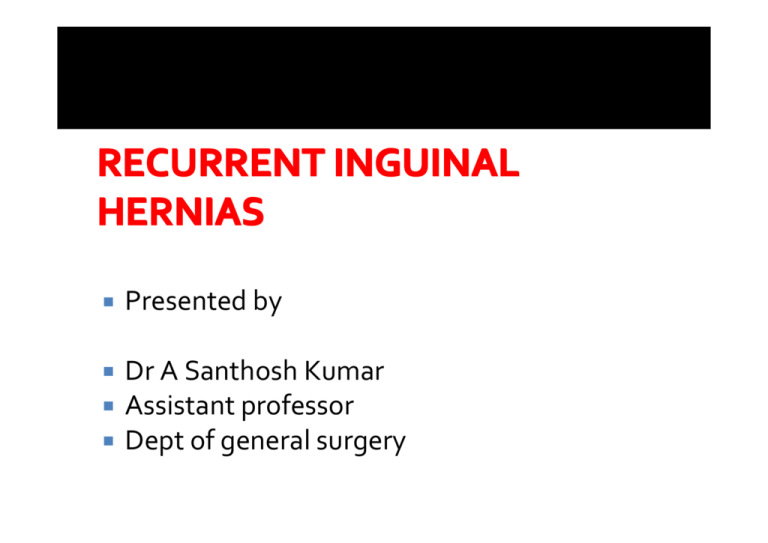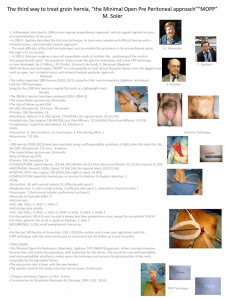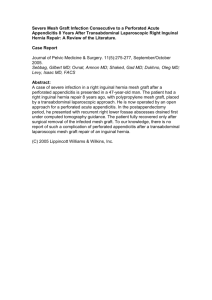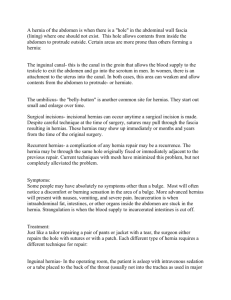Recurrent inguinal hernia
advertisement

RECURRENT INGUINAL HERNIAS � Presented by � Dr A Santhosh Kumar Assistant professor Dept of general surgery � � My discussion includes; � � � � � Briefly about inguinal hernias including its definition and various management tech. Regarding recurrent hernias Its difficulties Its management strategy Its prevention What is a hernia � Hernia is derived from the Latin for "rupture" It is the protrusion of an organ or part of an organ through a defect in the wall of the cavity normally containing it. Myopectineal Orifice of Fruchaud The MPO is bordered bordered: � � � � � Above - by the arching fibers of the internal oblique and transversus abdominus Muscles, Medially - by the Rectus Abdominus Muscle and its fascial Rectus Sheath Inferiorly - by Coopers Ligament, and Laterally - by the Ileopsoas Muscle Running diagonally through the MPO is the inguinal ligament. 4 Myopectineal Orifice of Fruchaud Etiology � � Hernias occur at sites of weakness in the wall. This weakness may be : � Normal (physiological) weakness, related to the anatomical causes. � Congenital abnormality. � Acquired : ▪ Traumatic ▪ Diseases – like Ehlers danlos syndrome and prune belly syndrome. � Inguinal hernia � Risk factors: ( increases intra-abdominal pressure ) � Chronic cough. � Constipation. � Pregnancy. � Straining at micturation. � Severe muscular effort (lifting heavy objects). � Ascites - fluid may increase the size of an existing sac. Management � Treatment: hernias should be operatively repaired both to relieve symptoms and to eliminate the complications. � Surgical techniques: ▪ Herniotomy: removal of sac and closure of its neck. ▪ Herniorrhaphy: involves some sort of reconstruction to: ▪ Restore the anatomy if this is disturbed. ▪ Increase the strength of the abdomenal wall. ▪ Construct a barrier to recurrence. Management.., � � Treatment of aggravating factors (chronic cough, prostatic obstruction, etc). Use of truss (appliance to prevent hernia from protruding) when a patient refuses operative repair or when there are other absolute contraindications to operation(not in use now) Specific Surgical Procedures � Lichenstein (tension free) Repair � McVay (coopers ligament)Repair � Shouldice( canadian )Repair � Laproscopic Hernia Repair � Bassini Repair � Stoppas GPRVS Lichtenstein Repair Tension-Free Repair One of the most commonly performed procedures A mesh patch is sutured over the defect with a slit to allow passage of the spermatic cord Recurrence upto 1 – 2% 11 Lichtenstein Repair Note: Open mesh repair. Mesh is used to reconstruct the inguinal canal. Minimal tension is used to bring tissue together. 12 McVay Repair � Cooper’s ligament Repair � Is for the repair of large inguinal hernias, direct inguinal hernias, recurrent hernias and femoral hernias. � The conjoined tendon is sutured to Cooper’s ligament from the pubic tubercle laterally. McVay Repair This repair reconstructs the inguinal canal without using a mesh prosthesis. Shouldice Repair � Canadian Repair � A primary repair of the hernia defect with 4 overlapping layers of tissue. � Two continuous back-and-forth sutures of permanent suture material are employed. The closure can be under tension, leading to swelling and patient discomfort. � Recurrence <1% Shouldice Repair Bassini Repair � Is frequently used for indirect inguinal hernias and small direct hernias. � The conjoined tendon and transversalis fascia is sutured to the inguinal ligament. Bassini Repair Laparoscopic Hernia Repair � Current techniques include ▪ Transabdominal preperitoneal repair (TAPP) ▪ Totally extraperitoneal approach (TEPA) Stoppas GPRVS � � Involves replacement of transversalis fascia in the groin and lower abdomen by large prosthesis that extends far behind myopectineal orifice. Recurrences - very minimal unless technical error. Recurrent inguinal hernia: defined as; Preoperatively – expansile cough impulse (or) a weakness in operative area necessitating a further operation or the provision of a truss. Postoperatively – recurrent groin hernia irrespective of type of hernia at the initial and subsequent operation. Recurrent inguinal hernia � The chance of recurrence is related to the experience of the operator as demonstrated by the results from shouldice clinic. Incidence � � Varies from 1% in specialized centers to 30% in general surveys. Most of them occur within 2-3 years. Recurrent inguinal hernia Factors that prevent hernia: � � � � � � Shutter mechanism of internal ring (lateral and cephalad displacement of internal ring beneath transversalis fascia and approximation of crura) Shutter mechanism of inguinal canal (conjoint tendon contract and straighten towards inguinal ligament) Plug mechanism) Cremasteric reflux ((Plug Obliquity of inguinal canal Ball valve mechanism of crura of SIR. Condensation of fascia transversalis towards SIR Classification-1: � True recurrence: It is because of previous operative failure. � False recurrence: It is because of missed sac during previous surgery (in complex hernias where there are multiple defects – 10 % ) 56.4% - direct and indirect 18% - direct and femoral 18% - indirect and femoral 07% - true complex involving all 3 along with an element of tissue loss. Classification-2 � Early recurrence --- technical failure � late recurrence --- tissue failure Causes � Of early recurrence(tech failure) • misidentification of anatomical hernias • too small mesh • inadequate fixation • inadequate dissection and reduction of peritoneal sac • inadequate restoration of disordered anatomy……. …., Continued Continued… • Inadequate suture tech inadequate size of mesh to overlap facial margins of post inguinal wall • wrong suture material. • Causes � Of late recurrence(tissue failure) • inadequate collagen replacement inadequate tissue stretching-cause another adjacent defect • infections • …, Difficulties Difficulties… � With regard to patient: • • • • � unacceptance embrassing cost and time factor ????? Rerecurrence With regard to surgeon: • convincing the patient • difficult surgical approach- destorted anatomy,fibrosis,collagen defect and occasional operator. • • ????? Rerecurrence may question his ability. Management � � � � No doubt it’s a clinical diagnosis Important is to rule out the cause for recurrence Manage his risk factors If possible chose an alternative technique. Management : � Open method with or without orchidectomy. � Laparoscopic method. Management � Best is preperitoneal (1.6% rerecurrence )or laparoscopic approach: avoids the previous scarred operative field and are less likely to have problems with spermatic cord and the sensory nerves. Laparoscopic repair � TAPP Vs TEPP: • TAPP – Indicated for repair of recurrent hernias as it will allow to dissect the peritoneum under direct vision allows the assurgence that there are no adhesions from other intra abdominal organs. • TEPP – more advantage than TAPP in comparing complications and recurrence because of non violating the peritoneal cavity in primary hernias hernias. but technically demanding and increased learning curve than TAPP. TAPP TAPP TAPP TEP Developing a plane Anatomy of Preperitoneal Space Indications for LAP: � � � Recurrent hernias Bilateral hernias Unilateral hernia with a suspected contralateral hernia. Contraindications of LAP: � Absolute: • • • • � cardiopulmonary distress C/I for general anesthesia giant scrotal hernias incarcerated hernias Relative : • unilateral hernias and • in herniotomies because too much Sx with LAP • Previous preperitoneal surgery. ADVANTAGES OF LAP: � � � � � � Less Pain Smaller scars Lower Wound infection Faster Return to activity Several hernias fixed through same incisions Recurrence rate varies between 0-11% based on the experiance. Post op course after LAP � � � � � � � Daycare / 1 night No restrictions Driving after 24hrs Exercise – as comfort allows Return to work 4 days Heavy lifting as they wish Sex – Encouraged Complications of LAP: � � � � � � Recurrence Seroma Haemorrage from injury to epigastric and other major vessels Injury to bowel , bladder and other structures Port site hernias paresthesias Management � Other techniques: • coopers ligament repair – excising previous scar and dissecting medial to previous dissection giving relaxing incisions. • mesh plug tech - (completely abandoned because of its complications) • patch tech – similar to repair of primary inguinal hernia. Other techniques ….., techniques… • Kugels technique (mini-invasive preperitoneal technique) similar to TEP by open incision. kugel patch kept covering all hernial sites. low recurrence rate(comparable with LAP) OTHER TECHNIQUES • Proline Hernia system (PHS (PHS)) consists of an anterior oval polypropylene mesh connected to posterior circular component. Different prosthetic materials � Biological meshes – • animal dermis • porceine small intestinal submucosa � Synthetic meshes • Absorbable – polyglactin 910 polyglycolic acid • Non absorbable – polypropylene,polyester,ePTFE, • Composite –combination of both. Recent advances : � Dynamic implant tech • 3D self retainind implant • No suturing • Centrifugal expansion. • Less recurrence. � Stem cell therapy to reinforce the growth of shutter mech. Complications � Of surgery for recurrence: • same complications as applicable for primary surgery. • other important include; significant morbidity femoral nerve injury ischemic orchitis chronic pain(inguinodynia) Conclusion � � Lichtenstein tension free repair – gold standard for primary as well as recurrent inguinal hernias because of ; most commonly performed surgery can be performed under LA less learning curve simple operation less recurrences and rerecurrences if performed with std tech. Preperitoneal and laparoscopic repair – gold std if surgeon is well experienced and comfortable. Our goal to achieve …, achieve… � Is hernia repair as “once in a lifetime experience” for our patients. Prevention of recurrence ????? recurrence????? � Can be minimized by following simple principles during surgery like; • identify all potential sites of herniation • repair of lax internal ring. • avoiding tension on tissues by using prosthetic materials. • proper hemostasis and preventing infections(50% of recurrences are caused by infections) • use suture material which can hold tissues for atleast 6 months (non absorbable suture)……… ….., Continued Continued… • mass conituous suturing technique including large • • • • bites of tissues. treatment of precipitating factors like reduce body wt before surgery, treat chronic cough and BPH and other straining factors. high dissection of sac upto deep ring early ambulation and unrestricted normal physical activities immediately in post op period minimal disection and gentle handling of tissues. …… Continued Continued…… ……,, • Use of large mesh which covers all the defects. • For pantaloon hernias , hoquet's manouvre to be fallowed. • Excision of lipoma of cord if detected. • Avoidance of dead space, hematoma formation and infections. • Cesation of antiplatelets and Anticoagulants 72 hrs before surgery to prevent haematoma formation. Key points … points… � � � Majority of recurrences occur at pubic tubercle due to inadequate overlap by mesh. Shifting , shrinkage ,curling of edges of mesh leads to recurrence. Identify all areas of potential herniation and use a patch that covers the entire myopectineal orifice and assure proper fixation and positioning of mesh. Technique to prevent recurrence “ the answer for this is probably the technique the surgeon uses most commonly and he is comfortable”.







